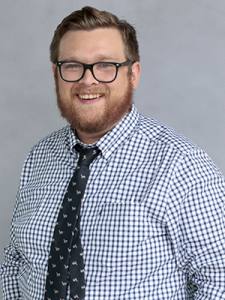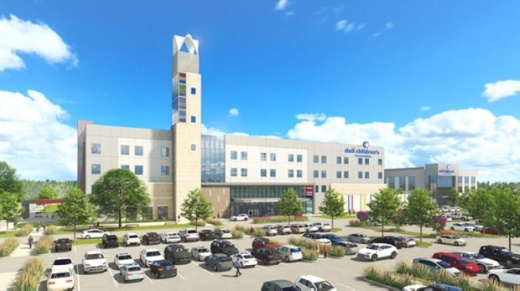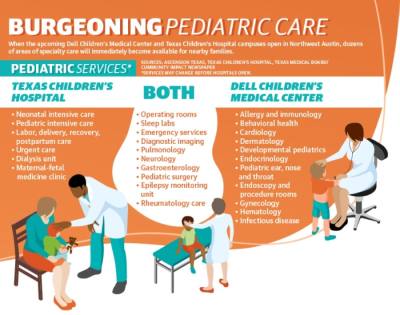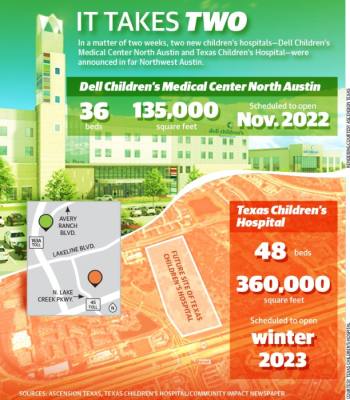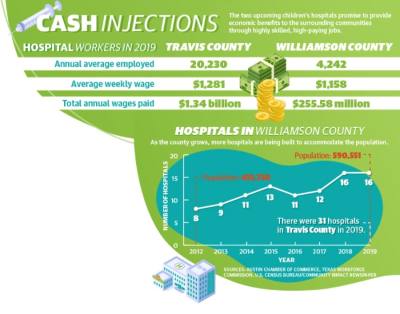Following the news that two children’s hospitals will be built in far Northwest Austin in the coming years, however, families from Northwest Austin, Cedar Park and other surrounding communities will soon have pediatric health care options right in their own backyards.
Ascension Texas announced plans May 7 to construct a new Dell Children’s Medical Center campus to be located at the intersection of Avery Ranch Boulevard and 183A Toll in Williamson County.
“I think it’s exciting to have a children’s hospital of Dell’s caliber coming to our area. This is a fantastic addition for better serving the needs of our residents,” Cedar Park Mayor Corbin Van Arsdale said in an email to Community Impact Newspaper at the time.
for better serving the needs of our residents,” Cedar Park Mayor Corbin Van Arsdale said in an email.
Less than two weeks later, one more children’s hospital was announced by another pediatric care network. Texas Children’s Hospital announced May 20 it will build a medical center at the northeast intersection of RM 620 and Lake Creek Parkway. This represents the first hospital expansion away from Houston for the Texas Children’s Hospital network.
Austin City Council Member Jimmy Flannigan calls the construction of two new children’s hospitals in Northwest Austin, located about 1 mile apart from each other, exciting news for “the fastest-growing part of the fastest-growing city.” The new children’s hospitals will be located in Flannigan’s District 6.
“It’s exciting for the health care that will be available to the high concentration of children and families we have here,” Flannigan said.
Christopher Born, president of Dell Children’s Medical Center, said Ascension was looking at other locations for its first hospital expansion, including a site in South Austin. Likewise, Texas Children’s Hospital has purchased land in South Austin, according to Executive Vice President Michelle Riley-Brown.
So why have two pediatric health care systems chosen this area in Northwest Austin to build their next children’s hospitals?
Executives with the hospital systems said the growth profiles of Northwest Austin and Cedar Park, combined with the opportunity to serve the greater Williamson County community, made the site a natural fit.
New pediatric services
When Born joined the Dell Children’s executive team more than two years ago, he said the medical center’s planning department had noticed a trend of local families leaving Austin for pediatric care and choosing instead to drive to Houston or Dallas for children’s hospitals.
In some cases, Born said, families have flown out to the East Coast for pediatric care at facilities in Philadelphia or Boston.
“We have the ability to build centers of excellence serving those children and families who needed to leave historically,” Born said.
The upcoming Dell Children’s Medical Center will include a variety of specialties, Born said, in an effort to serve Williamson County’s growing number of families.•When the hospital opens in November 2022, it will offer care for infectious disease; pulmonology; respiratory complications; neuroscience; gastroenterology; dermatology; and ear, nose and throat complications, to name a few, Born said.
Dell Children’s upcoming hospital will include an 18-bed pediatric emergency department, according to Ascension. Additionally, the hospital’s operating rooms will be able to care for newborns and children.
“This will be a great addition to an already growing medical community. This will allow access to specialty care that is important to so many parents to be right here in our backyard,” said Tony Moline, president and CEO of the Cedar Park Chamber of Commerce, in an email.•When operational, the new Dell Children’s campus will be designated as a Level III pediatric trauma center, Ascension stated.
Medical offices neighboring the hospital, scheduled to open eight months beforehand, will further house subspecialists for follow-up services, Born said.
Scheduled to open in late 2023, the 360,000-square-foot Texas Children’s facility will ultimately deliver 48 beds dedicated to an array of pediatric health services. The $48 million hospital will offer intensive care; epilepsy monitoring; diagnostic imaging; acute and urgent care; and labor, delivery, recovery and postpartum care, as well as other specialties.
“We intend to bring a full spectrum of services,” Riley-Brown said.
In 2018, the Houston-based hospital network opened a new, 51,000-square-foot pediatric specialty care clinic in North Austin.
According to a May 20 news release, that clinic and the upcoming hospital is part of Texas Children’s Hospital’s plan to bring primary care pediatric practices, urgent care clinics, specialty care locations and maternal-fetal medicine practices to the Austin area.
Keeping care local
These new hospitals will be able to serve families in nearby population hubs such as Cedar Park, Round Rock and Leander, all of which continue to see tremendous growth.
“We’ve been studying the Austin market for several years now. We know it is one of the fastest-growing communities,” Riley-Brown said. “We looked at the anticipated population growth. That is what is drove our decision.”
According to data released in late May by the U.S. Census Bureau, the city of Austin added the fifth-most residents—more than 177,000—of any city in the past decade. From 2010-19, Cedar Park’s population ballooned by 44.2%, making it the seventh-fastest growing city of more than 50,000 residents in the nation. Round Rock was also one of the top 20 fastest-growing cities in the U.S. over the past decade.
Leander more than doubled its population from 2010-19 and was officially listed as the fastest-growing large city in the U.S. from 2018-19.
Despite all of that growth, there are currently no children’s hospitals north of SH 45 N in Williamson County—only clinics at rehabilitation centers.
St. David’s Children’s Hospital in North Austin is currently the closest pediatric hospital to Williamson County residents, and it is located approximately 7 miles from Cedar Park’s southernmost boundaries.
“While we have a lot of small clinics in the area, the large hospital infrastructure really doesn’t match the rapid growth,” Flannigan said.
According to January 2020 data from the Texas Medical Board, there are 365 pediatric medical doctors practicing between Travis and Williamson counties combined. In comparison, there are 298 practicing pediatricians in Tarrant County itself.
Currently, there is just one pediatric specialist, an endocrinologist, working in Williamson County, according to medical board records.
Patients as far as Georgetown will benefit from these upcoming hospitals by being able to avoid driving into Austin for care, Born said
“As all that growth happens in the northeast, north and northwest sections of Austin, we can provide the same level of care for people who live up north as we do in Central Austin without them having to go up and down I-35,” Born said.
The economic impact of hospitals
When completed, the upcoming children’s hospitals will immediately employ hundreds of high-skill, high-wage workers.
Texas Children’s Hospital estimates its project will create 400 new jobs, and Ascension stated its Northwest Austin hospital will staff approximately
200 professionals just within its walls.
“To have a permanent and solid employer in this part of my district is going to have so many benefits to all the small businesses in that area,” Flannigan said.
According to Texas Workforce Commission data provided to Community Impact Newspaper by the Austin Chamber of Commerce, the hospital industry in Williamson County paid its professionals an average $1,158 per week in wages in 2019. Hospitals in the county paid more than $255 million in wages to workers last year, that data shows.
Medical centers also have the ability to create economic ecosystems that support their functions indirectly, local officials said.
“A hospital is a major anchor institution that brings with it smaller businesses related to the health care industry,” said Williamson County Judge Bill Gravell in an email exchange with Community Impact Newspaper. “Hospitals purchase a wide variety of goods and services from food service and medical supplies to janitorial services and lawn care, so it brings a range of jobs and small businesses opportunities.”
Gravell said Williamson County provided no tax incentives to either hospital through economic development deals. This means the county will collect full property and sales taxes from the hospital.
Further, local officials see these announcements as a signal to other prospective health care systems that it is time to invest in Williamson County as a burgeoning medical hub.
The area’s surging population will require health care needs to be met. That need, coupled with the investments from Ascension and Texas Children’s Hospital, should make Williamson County attractive to other medical providers.
“It verifies what we, and many other companies, already know, which is that Williamson County offers a complete package. We have dynamic communities, quality education, a skilled workforce, a well-developed infrastructure and superior health care,” Gravell said.
Ali Linan and Brian Perdue contributed to this report.


